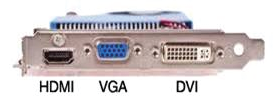Shopping for Flat Panel Monitors
As the price of flat panel monitors continues to drop, and screen sizes increase, computer users are looking increasingly to replace old tube monitors and smaller flatscreen displays. Here are some things you need to know:

Interface
When buying any new monitor, the most important consideration is to ensure that it will actually connect to your new or existing computer. Older computers included a VGA or D-sub connector for interface to a display monitor (which used a familiar 15-pin blue connector at the cable end). Newer computers may include only a digital DVI connector or an HDMI connector. Make sure that the monitor you select includes an interface compatible with your computer - many, but not all, monitors will include both VGA and DVI-style interfaces, plus the cables needed to interface with the computer, and some may or may not include an HDMI interface.
Size and Cost
The earliest flat panel monitors included 15 inch displays (measured diagonally at the inside edges of the picture frame), or roughly equivalent to large 17 inch tube monitors. Today, 19-20 inch flat panels are available in the $100 range, with 22-24 inch monitors costing $140-$175 and even larger 26-27 inch monitors available for $250-$300. Larger displays allow displaying more information at the same time, or the same amount of data in a larger font, or both. The downside is that monitors larger than perhaps 23 inches may be too large for smaller desks or computer workstations.

Almost all newer flat panel monitors are of the widescreen type, with traditional square monitors becoming a rarity. Most monitors also specify an 'optimum' screen resolution (the number of dots or 'pixels' displayed across or down the screen), which may result in a larger or smaller image than you may be used to seeing.
LED vs LCD
Technically speaking, all flat panel monitors are LCD type, but a new technology features LED backlighting. LED backlit displays are sharper, have a better range of colors, and use significantly less power than LCD-only displays. While LED-backlit monitors cost more, the better image display and energy savings is usually worth the extra cost.
Built-in Speakers
Some monitors are available with speakers built right into display. This is a convenient option if you don't already have speakers or want to reduce space requirements or cable clutter. Just remember that the sound quality will typically not be as good as what you'd get from a set of decent, powered external speakers.
USB Interface
A handy feature on some monitors is the availability of two or more USB interfaces right at the monitor case. Instead of reaching down to the computer case to connect or disconnect your USB jump drive, attach it right at the monitor. This feature is usually only available on higher priced monitors, and does take up one USB port at the computer end, but for some users can be very handy.
Other monitor considerations include maximum display resolution, contrast settings, and display response times. These are important factors for gamers and those doing serious graphics work, but usually not an issue for the typical office worker. Purchasing a new flat panel monitor needn't be an overly expensive or complicated process, and by observing the tips above, you should be able to find a display that matches both your needs and your budget.
Erie County Bar Association
www.eriebar.com
Tips provided by Richard D. Vasil, Vasil Consulting, Inc.
© 2012 Vasil Consulting, Inc.




